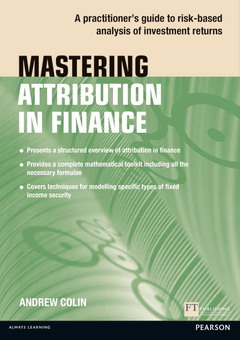Mastering Attribution in Finance A practitioner's guide to risk-based analysis of investment returns Financial Times Series
Auteur : Colin Andrew

Mastering Attribution in Finance is a comprehensive guide to how attribution is used in equity and fixed income markets.
Attribution in finance is a key investment and asset management process used in managed funds. A managed fund uses appropriate financial tools to make sure that the fund?s value is maintained or increased. Attribution tools are used to analyse why a portfolio?s performance differs from a benchmark. The difference between the portfolio return and the benchmark return is known as the active return.
As with all Mastering titles, this book is written by an expert in the field. It will show you how to:
- Understand how attribution is used in equity and fixed income markets
- Improve your knowledge of the mathematics used in performance and attribution
- Assess in greater detail the effects top-down attribution and attribution on specific types of fixed income security
- Broaden your awareness of performance and return
About the author
Acknowledgements
Preface
1 An introduction to attribution
1.1 Securities, portfolios and risk
1.2 Types of risk
1.3 Return and attribution
1.4 Strategy tagging
1.5 Types of attribution
1.6 Book structure
PART 1 Equity attribution
2 The basics of performance measurement
2.1 Introduction
2.2 Defining return
2.3 Compounded returns
2.4 Time-weighted and money-weighted returns
2.5 Portfolio returns
2.6 Transactions and cash flow
2.7 Sector returns
2.8 Calculating portfolio returns over successive intervals
2.9 Futures cash offsets
2.10 Edge cases
2.11 External returns
2.12 Benchmarks
2.13 Active return
2.14 Stochastic attribution
2.15 Liability-driven investment (LDI)
3 Equity attribution
3.1 Introduction
3.2 Brinson attribution
3.3 Single level Brinson attribution
3.4 Multiple-level asset allocation
3.5 Off-benchmark securities
3.6 Successive portfolio attribution
3.7 Security-level attribution
4 Currency attribution
4.1 Introduction
4.2 Currency attribution returns
4.3 Performance and attribution on unhedged portfolios
4.4 Attribution on an unhedged portfolio
4.5 Portfolio hedging
4.6 Currency forwards
4.7 Hedging and risk
4.8 Naïve attribution on a hedged portfolio
4.9 Measuring hedge returns
4.10 Brinson attribution on a hedged portfolio
4.11 Problems with the Brinson approach when hedging is active
4.12 Calculating base and return premiums
4.13 The Karnosky-Singer attribution model
4.14 Running Karnosky-Singer attribution on an unhedged portfolio
5 Smoothing algorithms
5.1 Why returns do not combine neatly over time
5.2 The importance of internally consistent return contributions
5.3 Path-independence
5.4 Carino smoothing
5.5 Geometric smoothing
5.6 Foreign exchange return and smoothing
5.7 Summary
PART 2 Fixed income attribution
6 An overview of fixed income risks
6.1 Introduction
6.2 What is a bond?
6.3 Pricing conventions
6.4 Maturity
6.5 Coupons
6.6 Discounted cash flows and net present value
6.7 Pricing a bond from its discounted cash flows
6.8 Bond yield and carry return
6.9 Prices and yields
6.10 Return of a bond
6.11 Credit effects
6.12 The three Cs
7 Yield curves in attribution
7.1 Introduction
7.2 Why interest rates vary by term
7.3 Interpolation
7.4 Par curves and zero curves
7.5 Credit spreads
8 Pricing, risk and the attribution equation
8.1 Introduction
8.2 Pricing securities from first principles
8.3 Calculating return using the perturbational equation
8.4 Residuals
8.5 Stand-alone portfolios
PART 3 Sources of fixed income return
9 Carry return
9.1 Introduction
9.2 Carry-based investment strategies
9.3 Types of yield
9.4 Calculating carry return
9.5 Pros and cons of YTM
9.6 Decomposing carry
9.7 Which yield to use?
9.8 Decomposing carry return
9.9 Yield for non-bond securities
9.10 Using yield to maturity in attribution reports
10 Sovereign curve attribution
10.1 Introduction
10.2 Yield curve models
10.3 Parallel shift and modified duration, and why they matter
10.4 Measuring twist
10.5 Taxonomy of curve shifts
10.6 Sources of yield curve data<
Andrew Colin is a leading authority in the field of investment performance attribution. He's worked at Citigroup, the Commonwealth Bank, Zurich Investment Management, JP Morgan, StatPro and Queensland University of Technology. He's also managed many consulting projects in defence and applied statistics.
Date de parution : 12-2015
Ouvrage de 312 p.
15.6x23 cm
Disponible chez l'éditeur (délai d'approvisionnement : 14 jours).
Prix indicatif 101,10 €
Ajouter au panier


